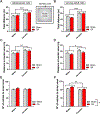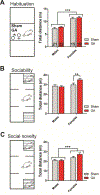Early exposure to general anesthesia impairs social and emotional development in rats
- PMID: 31494825
- PMCID: PMC6980478
- DOI: 10.1007/s12035-019-01755-x
Early exposure to general anesthesia impairs social and emotional development in rats
Abstract
Several animal and emerging human studies suggest an association between an early exposure to general anesthesia (GA) and long-lasting problems with complex social and emotional behaviors such as inattentiveness, impulsivity, anxiogenic tendencies, as well as difficulties engaging in proper social intercourse, with significant increase in attention deficit and hyperactivity-type behaviors. To further investigate these behaviors, and to examine the potential of presently available rodent behavioral models to guide future assessments of long-term socio-emotional impairments in humans, we examined the long-term effects of GA on anxiety/fear and social behaviors. We exposed male and female Sprague-Dawley infant rats at the peak of their synaptogenesis to either GA containing midazolam (9 mg/kg, i.p.), 70% nitrous oxide (N2O) and 0.75% isoflurane (Iso) administered in 29-30% oxygen (experimental), or air (with 30% oxygen) plus the vehicle, 0.1% dimethyl sulfoxide (Sham) for 6 h. Behavioral experiments were conducted at adolescence (the open-field test) and young adulthood (the open-field test, the elevated plus-maze and the social novelty test). We report that an early exposure to GA during critical stages of brain development results in long-lasting increase in risk-taking tendencies and significant changes in the anxiety-related behaviors when tested in young adult rats. In addition, we noted novelty-seeking tendencies/less guarded behavior with changes in social discrimination. We conclude that early exposure to anesthesia may have lasting influences on emotional and social development. Importantly, our results show that currently used rodent behavioral models could be a good correlate to assess long-term socio-emotional GA-induced impairments observed in humans.
Keywords: Developmental neurotoxicity; Rodents; Sex differences; Social interactions; Thigmotaxic behavior.
Figures






Similar articles
-
Repeated brief isoflurane anesthesia during early postnatal development produces negligible changes on adult behavior in male mice.PLoS One. 2017 Apr 5;12(4):e0175258. doi: 10.1371/journal.pone.0175258. eCollection 2017. PLoS One. 2017. PMID: 28380075 Free PMC article.
-
Impairments in cognitive functions and emotional and social behaviors in a rat lithium-pilocarpine model of temporal lobe epilepsy.Behav Brain Res. 2019 Oct 17;372:112044. doi: 10.1016/j.bbr.2019.112044. Epub 2019 Jun 17. Behav Brain Res. 2019. PMID: 31220488
-
Integrating the open field, elevated plus maze and light/dark box to assess different types of emotional behaviors in one single trial.Behav Brain Res. 2008 Nov 21;193(2):277-88. doi: 10.1016/j.bbr.2008.06.007. Epub 2008 Jun 11. Behav Brain Res. 2008. PMID: 18590774
-
The Role of Free Oxygen Radicals in Lasting Hyperexcitability of Rat Subicular Neurons After Exposure to General Anesthesia During Brain Development.Mol Neurobiol. 2020 Jan;57(1):208-216. doi: 10.1007/s12035-019-01770-y. Epub 2019 Sep 6. Mol Neurobiol. 2020. PMID: 31493241 Free PMC article.
-
Isoflurane Anesthesia Has Long-term Consequences on Motor and Behavioral Development in Infant Rhesus Macaques.Anesthesiology. 2017 Jan;126(1):74-84. doi: 10.1097/ALN.0000000000001383. Anesthesiology. 2017. PMID: 27749311 Free PMC article.
Cited by
-
Enhancement of astrocytic gap junctions Connexin43 coupling can improve long-term isoflurane anesthesia-mediated brain network abnormalities and cognitive impairment.CNS Neurosci Ther. 2022 Dec;28(12):2281-2297. doi: 10.1111/cns.13974. Epub 2022 Sep 25. CNS Neurosci Ther. 2022. PMID: 36153812 Free PMC article.
-
Do We Have Viable Protective Strategies against Anesthesia-Induced Developmental Neurotoxicity?Int J Mol Sci. 2022 Jan 20;23(3):1128. doi: 10.3390/ijms23031128. Int J Mol Sci. 2022. PMID: 35163060 Free PMC article. Review.
-
Behavioral Voluntary and Social Bioassays Enabling Identification of Complex and Sex-Dependent Pain-(-Related) Phenotypes in Rats with Bone Cancer.Cancers (Basel). 2023 Mar 2;15(5):1565. doi: 10.3390/cancers15051565. Cancers (Basel). 2023. PMID: 36900357 Free PMC article.
-
Midazolam Exposure Impedes Oligodendrocyte Development via the Translocator Protein and Impairs Myelination in Larval Zebrafish.Mol Neurobiol. 2022 Jan;59(1):93-106. doi: 10.1007/s12035-021-02559-8. Epub 2021 Oct 9. Mol Neurobiol. 2022. PMID: 34626343
-
Association between general anesthesia in early childhood and neurodevelopment up to 4 years of age: the Japan Environment and Children's Study.J Anesth. 2024 Oct;38(5):609-621. doi: 10.1007/s00540-024-03359-9. Epub 2024 Jun 7. J Anesth. 2024. PMID: 38847849 Free PMC article.
References
MeSH terms
Substances
Grants and funding
LinkOut - more resources
Full Text Sources
Medical

